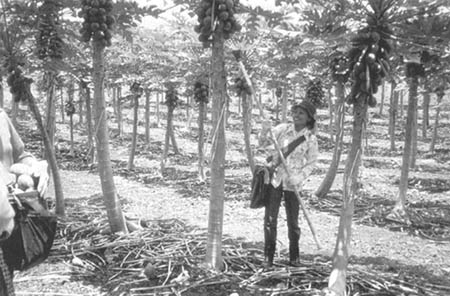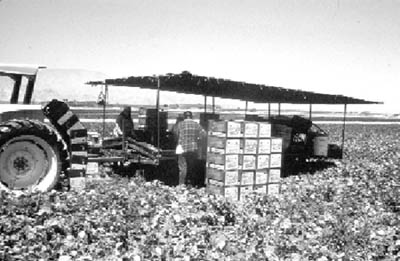Within each commodity grouping there is a range of genotypic variation in composition, quality, and post-harvest-life potential. Plant breeders have been successful in selecting carrot, sweet potato, and tomato cultivars with comparably high carotenoid levels and vitamin A content; onion and tomato cultivars with longer shelf-lives, sweet corn cultivars that maintain their sweetness longer after harvest; cantaloupe and watermelon cultivars with higher sugar content and firmer flesh, and pineapple cultivars with higher contents of ascorbic acid, carotenoids, and sugars. These are just a few examples of how genetic manipulation has contributed to improving the quality of fruits and vegetables. However, in many cases, commercial cultivars selected for their ability to withstand the rigors of marketing and distribution, tend to lack sufficient sensory quality, in particular flavor.
Horticultural plant breeders have an unprecedented opportunity to address human nutritional needs by developing fruit and vegetable cultivars that are rich in nutrients. In so doing, a multidisciplinary approach should be taken with emphasis the enhancement of nutritional quality for maximum impact on human nutrition and wellness.
Many opportunities exist for applying biotechnology to improving the post-harvest quality and safety of fresh produce. Priority goals in this regard, should, be focused on: (1) attaining and maintaining good flavor and nutritional quality, so as to satisfy consumer demands and (2) introducing resistance to physiological disorders and/or decay-causing pathogens, so as to reduce the use of chemicals on fruits and vegetables.
Climatic factors, in particular temperature and light intensity, greatly impact on the nutritional quality of fruits and vegetables. Consequently, the location of production and the season in which plants are grown can determine their ascorbic acid, carotene, riboflavin, thiamine, and flavonoid contents. In general, the lower the light intensity the lower the ascorbic acid content of plant tissues. Temperature influences the uptake and metabolism of mineral nutrients by plants, since transpiration rates increase with increasing temperature. Rainfall affects water supply to the plant, which may influence the composition of the harvested plant part and its susceptibility to mechanical damage and decay during subsequent harvesting and handling operations.
Soil type, the rootstock used for fruit tree cultivation, mulching, irrigation, and fertilization influence the water and nutrient supply to the plant, which can in turn affect the nutritional quality of the harvested plant part. The effect of fertilizers on the vitamin content of plants is less important than are the effects of genotype and climatic conditions. The effects of mineral and elemental uptake from fertilizers by plants are, however, significant and variable. Selenium and sulfur uptake for example influence the concentrations of organosulfur compounds in Allium and Brassica species. High calcium uptake in fruits has been shown to reduce respiration rates, and ethylene production, to delay ripening, increase firmness, and reduce the incidence of physiological disorders and decay, all of which result in increased post-harvest shelf-life. High nitrogen content on the other hand, is often associated with reduced post-harvest-life due to increased susceptibility to mechanical damage, physiological disorders, and decay. Increasing the nitrogen and/or phosphorus supply to citrus trees results in somewhat reduced acidity and ascorbic acid content in citrus fruits, while increased potassium fertilization results in increased acidity and ascorbic acid content.
Numerous physiological disorders are associated with mineral deficiencies. Bitter pit of apples; blossom-end rot of tomatoes, peppers, and watermelons; cork spot in apples and pears; and red blotch of lemons are all associated with calcium deficiency in these fruits. Boron deficiency results in corking of apples, apricots, and pears; lumpy rind of citrus fruits, and cracking of apricots. Poor color of stone fruits may be related to iron and/or zinc deficiencies. Excess sodium and/or chloride (due to salinity) results in reduced fruit size and higher soluble solids content.
Severe water stress results in increased sunburn of fruits, irregular ripening of pears, tough and leathery texture in peaches, and incomplete kernel development in nuts. Moderate water stress reduces fruit size and increases soluble solids content, acidity, and ascorbic acid content. On the other hand, excess water supply to plants results in cracking of fruits (such as cherries, plums, and tomatoes), excessive turgidity leading to increased susceptibility to physical damage (such as oil spotting on citrus fruits), reduced firmness, delayed maturity, and reduced soluble solids content.
Cultural practices such as pruning and thinning determine the crop load and fruit size, which can in turn influence the nutritional composition of fruit. The use of pesticides and growth regulators does not directly influence fruit composition but may indirectly affect it due to delayed or accelerated fruit maturity. Effective pre-harvest disease control greatly influences disease incidence and severity during post-harvest handling of fruits and vegetables
Maturity at harvest is the most important determinant of storage-life and final fruit quality. Immature fruit are highly susceptible to shriveling and mechanical damage, and are of inferior flavor quality when ripe. Overripe fruit are likely to become soft and mealy with insipid flavor soon after harvest. Fruit picked either prematurely or too late, are more susceptible to post-harvest physiological disorders than are fruit picked at the proper stage of maturity.
With a few exceptions all fruits attain optimal eating quality when allowed to ripen on the plant. Some fruits are, however, picked at a mature but unripe stage of development so as to allow them to withstand post-harvest handling conditions when shipped over long-distances. Maturity indices for such fruit are based on a compromise between those indices that would ensure the best eating quality to the consumer and those that provide flexibility in marketing.
Fruit can be divided into two groups: (1) those that are incapable of continuing their ripening process once removed from the plant, and (2) those that can be harvested at the mature stage and allowed to ripen off the plant. Group 1 includes cane berries, cherry, citrus fruits, grape, lychee, pineapple, pomegranate, strawberry, and tamarillo. Group 2 on the other hand, includes apple, apricot, avocado, banana, cherimoya, guava, kiwifruit, mango, nectarine, papaya, passion fruit, pear, peach, persimmon, plum, quince, sapodilla, and sapote.
Fruit of the Group 1 category, produce very small quantities of ethylene and do not respond to ethylene treatment except in terms of degreening (removal of chlorophyll); these should be picked when fully-ripe, if good flavor quality is to be ensured. Fruit of the Group 2 category on the other hand, produce comparably larger quantities of ethylene which is associated with their ripening, and undergo more rapid and uniform ripening upon exposure to ethylene.
Many vegetables, in particular leafy vegetables, and immature fruit-vegetables (such as cucumbers, sweet corn, green beans, peas, and okras), attain optimum eating-quality prior to reaching full maturity. This often results in delayed harvest, and consequently in produce of low quality.
The method of harvesting (hand vs mechanical) can significantly impact upon the composition and post-harvest quality of fruits and vegetables. Mechanical injuries (such as bruising, surface abrasions and cuts) can accelerate loss of water and vitamin C resulting in increased susceptibility to decay-causing pathogens. Most fresh fruits and vegetables and all flowers are harvested by hand. Root crops (such as carrot, onion, potato, and sweet potato) and some commodities destined for processing (such as processing tomatoes, European plums, and tree nut crops) are mechanically harvested.

Figure 3: Harvesting Papayas
Management of harvesting operations, whether manual or mechanical, can have a major impact on the quality of harvested fruits and vegetables. Proper management procedures include selection of optimum time to harvest in relation to product maturity and climatic conditions, training and supervision of workers, and proper implementation of effective quality control. Expedited and careful handling, immediate cooling after harvest, maintenance of optimum temperatures during transit and storage, and effective decay-control procedures are important factors in the successful post-harvest handling of fruits and vegetables.
Attention must be paid to all of these factors, regardless of the method of harvesting used. These factors are nevertheless more critical in the case of mechanically harvested commodities.
It should be noted that any practice that reduces the number of produce handling steps will help minimize losses. Field packing (selection, sorting, trimming, and packaging) of produce at the time of harvest can greatly reduce the number of handling steps in preparation for marketing. Mobile field packing stations with adequate shading are used for those fruits (such as grapes and strawberries) and vegetables (such as broccoli, cauliflower, and green beans) that do not require washing as part of their preparation for marketing.

Figure 4: Field Packing of Green Beans